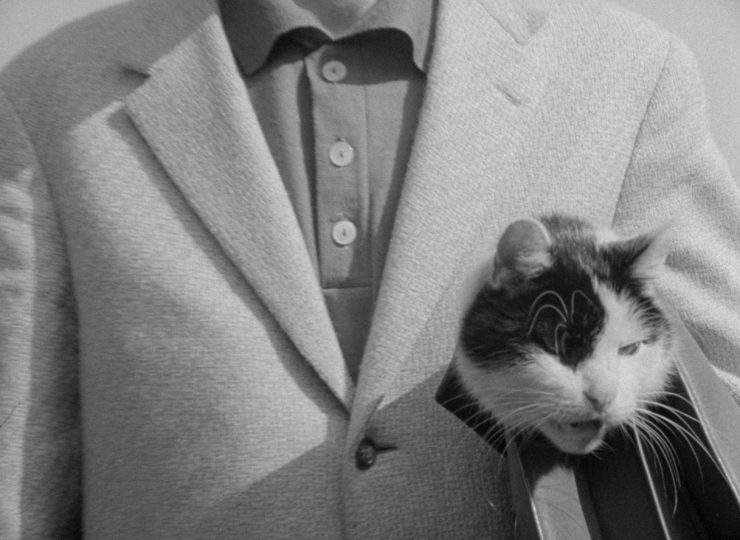Since the beginning of its production, the film A Character in Need of Support (Postava k podpírání, 1963) and by analogy also its author, Pavel Juráček[1], were unable to shake a certain Kafkaesque stigma attached to the work partly by period critics[2] who directly and indirectly attributed a Kafkaesque atmosphere to it; partly by representatives of the artistic council of the creative group Fikar – Šmída[3], which produced the film; or even by the director of Czechoslovak Film himself, Alois Poledňák, who allegedly reproached Juraček for being influenced by the 1962 film adaptation of Kafka’s novel The Trial: “The fate of Character is uncertain. The Central Committee (apparently warned by Váňa) requested it for a screening. Poledňák and Kunc dissociate themselves from it, and Fikar is scared.[4] Someone once said that you can’t use Kafka to fight a cult… (…) I already know that they will try to discredit Character by accusing it of epigonism. They will choose the most insidious way: indulgent irony. With a protectionist smile, Poledňák told me that I have learned a lot from Orson Welles. When I objected that I saw The Trial after we had already started shooting and therefore had already finished the shooting script, he calmed me with the following words: ‘But that wasn’t a reprimand, comrade Juraček; that was a compliment, as not everyone can learn so well.’ And I remember going to see The Trial shaking with excitement and dread as I feared I would find in it many things I had prepared for Character. (…) Welles’ film was something else and Character had nothing to do with it. (…) So when Poledňák told me in his deep statesmanlike voice that I had copied Welles, I realised that it was only the first of many similar pronouncements I would keep on hearing and reading and against which I would not be able to find a defence. Whom should I tell that I hadn’t even thought of Welles’ film during shooting? To whom should I confess that I barely even know Kafka?”[5]
The following article will compare the narratives of all three works in question – A Character in Need of Support, Kafka’s The Trial, and its film adaptation by Orson Welles – to explore what connects them and what could possibly prove the (un)justified period (and contemporary) comparisons of A Character in Need of Support to Kafka’s The Trial. The similarity of certain aspects of Juraček’sfilmand Kafka’s novel is probably apparent to the recipients of these works. The main protagonists of both stories find themselves in situations in which their own logic of how things work (in line with the logic of the real world) is confronted with an opposite logic that disrupts the integrity of their lives and is adopted by most characters they meet. But whereas Josef K., the main hero of The Trial, recognizes the absurdity of such a situation and subsequently detaches himself from the world, the main hero of Character conforms to the opposite logic – and his becoming an outcast caused by a mere coincidence; his fate could have befallen anyone who borrowed a cat that day. When he points out a flaw in the system to the clerks, he, in fact, acts as a regular citizen, as evidenced by a number of other people waiting for their problems to be resolved. But when he finds out that his situation is unresolvable, he has apparently[6] no trouble accepting his fate. So, instead of an analogy to Josef K., the protagonist of Character presents an analogy to the accused whom Josef K. meets during his trial and who accepts every order without any reservations.[7] The protagonist of Character is primarily a person who is unable to comprehend what’s happening around him and accepts the ensuing injustice even though he would like to restore order to his matters as soon as possible. This is underscored through a line heard throughout the film in different variations: “I don’t understand.” Josef K., on the other hand, sees the absurdity of the bureaucratic apparatus and the injustice he faces, and that triggers an existential crisis as his expectations of life are shattered.
As opposed to the film, the literary presentation of Josef K.’s realisation of the absurdity of the situation has much broader possibilities for an exact description of his state of mind,[8] but that can’t justify the lack of insight into the character’s mind in Character. Especially given the fact that we see a certain psychologization of Josef K. not only in the book but in Welles’ film adaptation. And while Josef K. fells dizzy both in the book and the film when leaving the building (image 1), the protagonist of Character shows no sign of being affected by injustice (image 2).[9] In dialogues with other characters, Josef K. often gets irritated and even informs others about his psyche and appeals to the accused and clerks around him. “I have fallen into despair and wish not to see anything else. I wish to get out of here and be alone.”[10] Josef K. feels that he is a victim of great injustice,[11] which is a manifestation of his conviction of his own superiority[12] connected to his professional status as a head bank clerk[13]. The protagonist of Character doesn’t look down on anybody, a result of the fact that, as opposed to Josef K., he is unable to make contact with anybody, and so his potential feeling of superiority, injustice and attitude towards others cannot emerge. The Trial presents Josef K.’s relationships with several people (Ms. Bürstner, Mrs. Grubach, Uncle Albert, the attorney Huld, the maid Lena, the businessman Bloch, etc.). The protagonist of Character, however, doesn’t have any relationships, even though a phone call and subsequent preparation of a sofa for a sleepover indicate that he will have a visitor. Even his relationship with Kilián, whom he is looking for, is rather unclear. But given the fact that he is unable to identify Kilián at the end of the story, this relationship is of little significance.
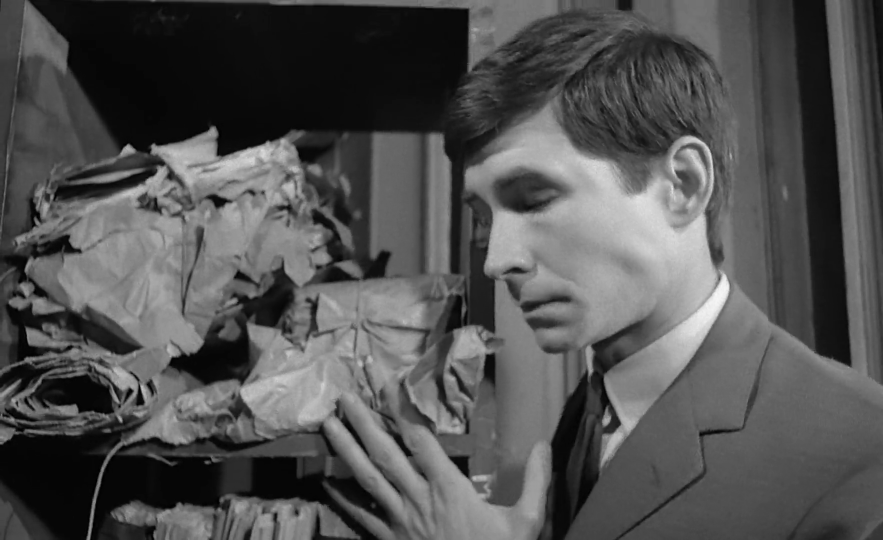
Image 1 (1:09:16)
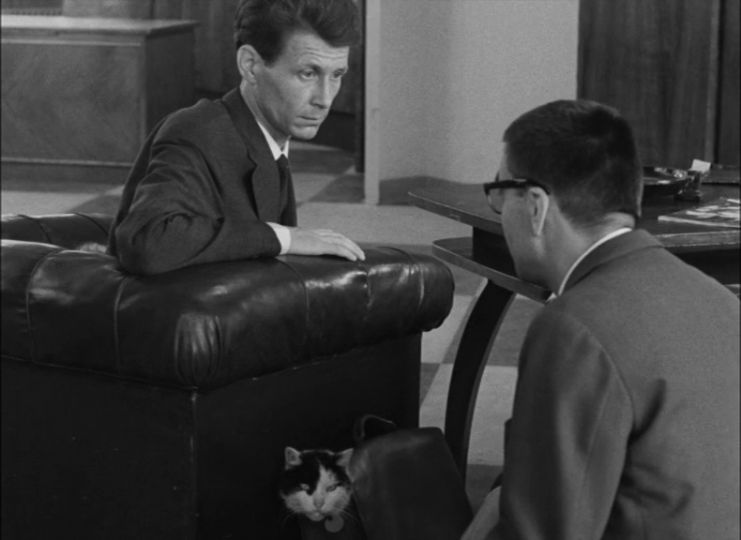
Image 2 (22:23)
With regards to the narratives in question, the approach of the narrators to the main characters and the way they see them through the narrative discourse is also different[14]. The narrator of Character takes a rather critical stand towards the protagonist, whether by framing the story with argumentative passages, using stop-shots or playing non-diegetic jazz music. We need to perceive the beginning of the film as an argument with suppressed narration and metaphorical emphasis on the portrayed events – three groups successively pass through a crossing of two streets: a kindergarten class, an army unit and a cortège – representing the cyclicality and a certain monotony of human life. The end of the film can be seen analogically. The alleged Kilián leaves a garden restaurant carrying a cat, just like the main protagonist – the protagonist’s fate depicted sketchily by the film eventually becomes a generality, not an exception as it could have been perceived until that moment. The narrator uses stop-shots (both in visual and audio tracks) to stop events on the street on which the protagonist is walking in order to rhetorically emphasise the mutual human alienation, applying to the people around him, delivering variations of the line “I don’t understand you”, and to the protagonist himself – whose only personal and intimate conversation depicted is when he utters a mere two lines while talking on the phone: “Hello” and “Buy some cigarettes then.”[15] The narrator uses non-diegetic jazz music to accentuate a certain ironical attitude he takes towards the main character particularly in the moment when he wanders through the administrative building’s corridors – the score is a certain emotional corrective to the protagonist’s unconcerned expression and emphasises his unwitting indifference to the result of his actions.
The narrator of the literary original of The Trial lacks similar critical tendencies. Both narratives start in medias res and end after the story ends with the death of Josef K., so we cannot talk about a certain “mythical” exposition or an open (and therefore somehow cyclical) ending, as is the case with Character. The narrators of the novel and film adaptation both assume a neutral non-commenting attitude towards Josef K. Furthermore, the literary original has frequent focalisations that make it harder to differentiate the voice of the narrator from Josef K.’s own thoughts: “… but when K. looked up and saw his dry, boney face it did not seem to fit with the body. His strong nose twisted to one side as if ignoring K. and sharing an understanding with the other policeman. What sort of people were these? What were they talking about? What office did they belong to? K. was living in a free country, after all, everywhere was at peace, all laws were decent and were upheld, who was it who dared accost him in his own home?”[16] The film adaptation, on the other hand, does not work systematically with Josef K.’s focalisation, and the narrator describes the protagonist’s thoughts in concrete situations from the outside, using an expressionistically presented setting that consumes Josef K. and represents a certain feeling of the protagonist’s uneasiness (image 3 and 4). In this sense, the score is also expressionistic as indicated by dynamic jazz music played during the action scenes when he chases a law student kidnapping the wife of a court usher or when he runs away from girls who want to get to the studio of the painter Titorelli with him.[17] Compared with that of both medially different versions of The Trial, Juráček comes up with a narrative innovation of not only the distance between the protagonist and other people inhabiting the fictional world, but also the distance of the narrator and the protagonist.

Image 3 (0:30:12)
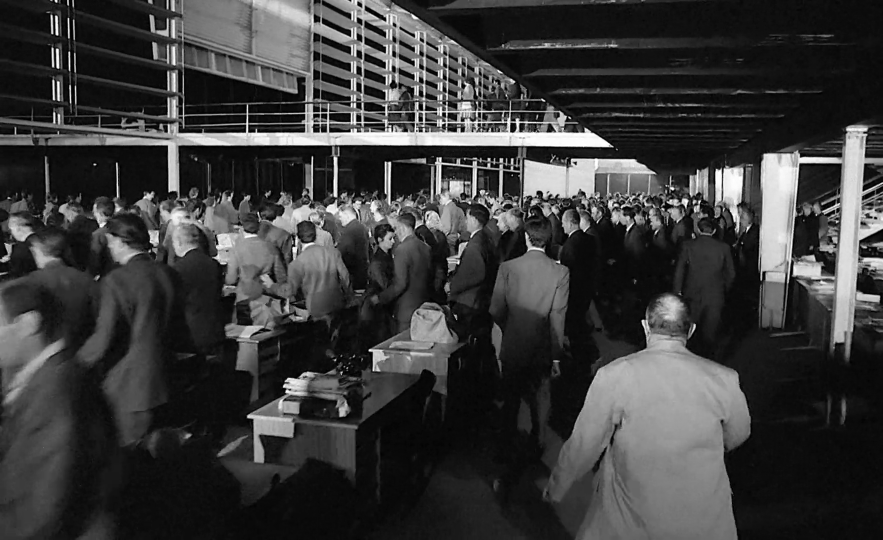
Image 4 (0:40:35)
However, clear analogies between Character and the literary and film versions of The Trial can be seen in the scenes of the protagonist’s search. The surprising space of the investigation room hidden behind a closed door (image 5) and an uncommon placement of offices in the attics of old houses in the literary and film version of The Trial find a parallel in the protagonist’s search for an (empty) office room and its adjacent waiting room in Character, but also in the jazz band in the Clam-Gallas Palace basement. But while the space in Character shows a certain illogicality – particularly in the scene when a man with a boiler ascends the stairs (image 6) but instead of walking up from a landing, he always descends one floor down – the space of the court office in The Trial is logically functional albeit, much like in Character, very non-conventional and impractical. A distinct similarity to the literary version can be seen in the scene in which the protagonist asks people on the street if they know where a cat rental place is, and the people obligingly respond and some even join in his search. A similar situation ensues at the beginning of the second chapter of The Trial – Josef K. is looking for an investigation room in an old building and, while pretending to be looking for a joiner named Lanz, asks individual tenants to find out whether an investigation room is hidden somewhere behind their doors: “There were many who thought it must be very important for K. to find Lanz the joiner and thought long about it, naming a joiner who was not called Lanz or giving a name that had some vague similarity with Lanz, or they asked neighbours or accompanied K. to a door a long way away where they thought someone of that sort might live in the back part of the building or where someone would be who could advise K. better than they could themselves. K. eventually had to give up asking if he did not want to be led all round from floor to floor in this way.”[18]
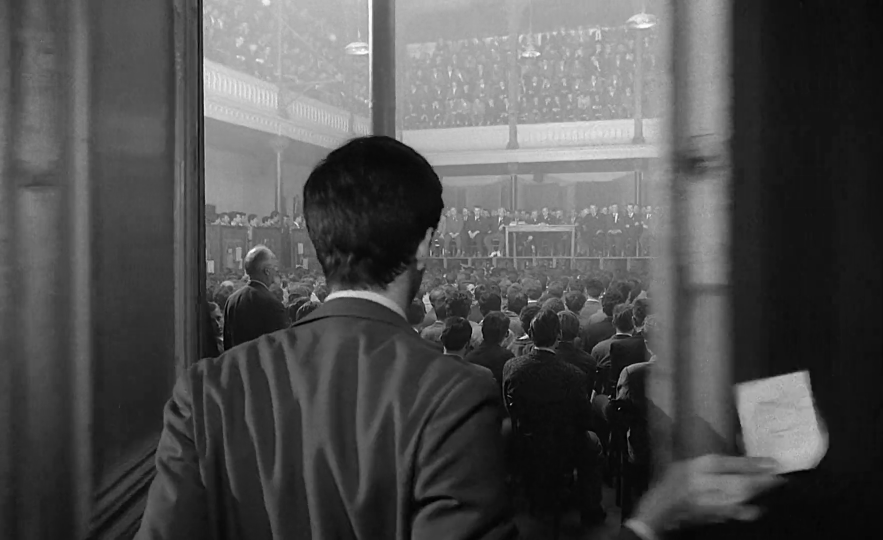
Image 5 (0:30:39)
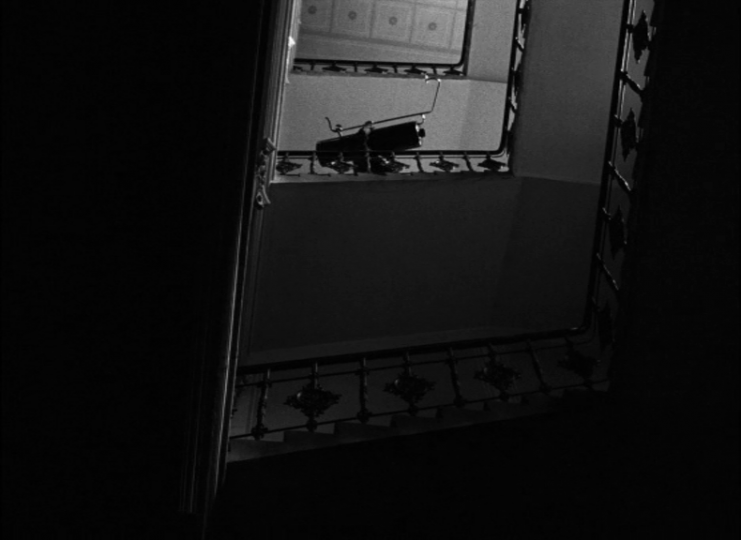
Image 6 (33:57)
The most fundamental difference between Character and The Trial supporting Juráček’s assertion of having made his film independently of Kafka is the genre of these works. The Trial’s story structure corresponds (in the original as well as in the adaptation) with a psychological drama – unlike Character’s protagonist, Josef K. manifests a certain development from the initial defiance towards society all the way to the final resignation and succumbing to the truth of the majority. The protagonist of Character not only doesn’t go through a visible psychological change, but due to the illogicality of the things he experiences and the absence of a broader bond with other people, he doesn’t come across as a real person. And while the story of Josef K. is told chronologically and has no major time jumps, with Character we simply can’t say that it represents a compact story, as it is divided into individual scenes or anecdotes with the protagonist as a uniting figure – the emphasis is therefore put on the absurdity of the situation rather than the point of view of the protagonist and his psychological portrayal. As far the genre is concerned, with its distance from the protagonist, Character is close to comedy genres even though it gives few reasons to laugh: “I considered Character to be a slapstick and assumed it would be funny. But when it was done and people saw it, they didn’t laugh much – and when they did laugh, it was so weird it perplexed me. Afterwards, they told me that they wanted to laugh but felt embarrassed as it would have been a cynical laughter.”[19]
In comparison with Character, the absurdity of The Trial comes out predominantly of the inverted values of the fictional world in relation to the real world inhabited by the reader / recipient of the work (implied by the author). Without his bringing about or awareness of the forthcoming change, Josef K. (just like in Metamorphosis) gradually becomes a social outcast because either the society’s values have changed or his own have. And due to being unaware of this change and because of its subtleness[20], he, just like the reader / recipient, cannot understand what his transgression is. The situations he finds himself in are therefore absurd only for him and the reader / recipient, not for other characters from the fictional world. But the absurd situations in Character are apparently absurd only to the viewers since the protagonist and the clerks adopt a rather forgiving attitude. By fragmenting Character into separated scenes, Juráček creates – rather than a believable fictional world – a series of metaphors relating to situations whose absurdity can be observed even in the real world. On the other hand, the figurativeness of The Trial is built on a logically coherent fictional world that is absurd as a whole and creates (by means of psychologization of the protagonist) an image of an existential crisis of a man who cannot find understanding in the outside world.
The aforementioned and rather significant differences between A Character in Need of Support and the literary and film versions of The Trial in some measure disprove the accusations of Juráček’s epigonism and can be seen as a proof that his story and his film presentation were relatively innovative for his time.[21] By rejecting an active and immersed main protagonist[22], he wanted to heighten the absurdity of the given situation, which in the case of the protagonist’s defiance or psychological disgust couldn’t come across as comical. With the absence of presentation of the protagonist’s psyche, he also drew the attention to the story and thus to a reflection of a social system which produces similar situations. And, lastly, the critical attitude towards the main protagonist that he assigned to the film’s narrator didn’t make him a victim of the system like Josef K., but rather one of the cogs in the machine driving this system.
Notes:
[1] Even though the film was made as a directorial collaboration with Jan Schmidt, Schmidt himself admits that his work was marginal and purely realisational: “Pavel had great ideas but was an inexperienced director. So we created an ideal form of collaboration when I was the practitioner and he the theorist. He came up with ideas, and I looked for a way to materialise them.” KOPANĚVOVÁ, Galina. Jan Schmidt. Jsem realizační typ. Film a doba 15, 1969, issue 6, p. 304.
[2] For more see: MOHYLA, Karel. Franz Kafka v dobové recepci filmu Postava k podpírání. In: Filmový přehled [online]. 14th June 2019. Available at: https://www.filmovyprehled.cz/en/revue/detail/franz-kafka-in-the-period-reception-of-the-film-joseph-kilian
[3] Bohumil Šmída (1914–1989) – director of Film Studios Barrandov, producer, head of production of the FSB creative group Fikar–Šmída. Ladislav Fikar (1920–1975) – poet, translator, head of production of the FSB creative group Fikar–Šmída.
[4] Otakar Váňa (1927–2012) – film critic, translator, editor. Alois Poledňák (1922–1984) – politician, director of Czechoslovak State Film. František Břetislav Kunc (1922–1982) – screenwriter, director, Head Dramaturge of FSB.
[5] JURÁČEK, Pavel. Postava k podpírání: (groteska 1962–1963). Prague: Václav Havel Library, 2016, p. 144–145.
[6] The protagonist’s reaction to the hopelessness of his case is not particularly accentuated in the narration.
[7] “When those who were sitting nearest the door saw K. and the usher of the court, they stood up to greet them, and when the others saw that, they also thought they had to greet them, so that as the two of them went by all the people there stood up (…) ‘What is it you are waiting for here?’ asked K., politely, but the man was startled at being spoken to unexpectedly, which was all the more pitiful to see because the man clearly had some experience of the world and elsewhere would certainly have been able to show his superiority and would not have easily given up the advantage he had acquired. Here, though, he did not know what answer to give to such a simple question and looked round at the others as if they were under some obligation to help him, and as if no-one could expect any answer from him without this help.” KAFKA, Franz. The Trial, www.holybookscom., translated by David Wyllie
[8] Kafka’s original alternatively uses psychonarration when the mind of the character is expressed in the layer of the narrator, and a narrated inner monologue, that, unlike with psychonarration, has the narrator explore the subjectivity of the character, i.e. its focalisation. The differentiation of the narration of minds of fictional characters is taken from: KOTEN, Jiří. Jak se fikce dělá slovy: pragmatické aspekty vyprávění. 1st Edition, Brno: Host, 2013. p. 118–123. Teoretická knihovna; issue 32. ISBN 978-80-7294-846-8.
[9] I see the protagonist’s line that he says to the fourth clerk not as a criticism of bureaucracy, but rather as his own defence: “I am not insulting anybody, comrade. I just can’t stand it when someone treats me as a moron!” A Character in Need of Support [film]. Directed by Pavel JURÁČEK. Czechoslovakia, 1963. In: Case for a Rookie Hangman / A Character in Need of Support. [DVD] NFA, 2017, 00:18:24–32.
[10] The Trial. Directed by Orson WELLES. France / Italy / West Germany, 1962, 1:08:45–50.
[11] See an excerpt from his defence during the first investigation: “And what, gentlemen, is the purpose of this enormous organisation? Its purpose is to arrest innocent people and wage pointless prosecutions against them which, as in my case, lead to no result.” KAFKA, The Trial, p. 35.
[12] “Do I, he thought to himself, do I really have to carry on getting tangled up with
the chattering of base functionaries like this? – and they admit themselves that they are of the lowest position. They’re talking about things of which they don’t have the slightest understanding, anyway. It’s only because of their stupidity that they’re able to be so sure of themselves. I just need few words with someone of the same social standing as myself and
everything will be incomparably clearer, much clearer than a long conversation with these two can make it.” ibid, p. 7.
[13] As a clerk he becomes a victim of the machinery he himself is a part of.
[14] I base this on the theory of Seymour Chatman and his differentiation of two elements of the narrative – story and discourse. While the story is formed by relations of events and the existents of the story (characters and setting), the discourse is a way a presentation of these relations and various media (literature, film, theatre, radio, comics) manifest narrative discourses differently and that enables e.g. an adaptational transition of an identical story from one media to another but also a retelling within the same medium. CHATMAN, Seymour Benjamin. Story and Discourse: Narrative Structure in Fiction and Film
[15] In the scene of the phone call, the image is stopped, rewound and replayed – the protagonist unwittingly knocks down a cat sitting on the couch, and we see this three times.
[16] KAFKA, The Trial, p. 5.
[17] Apart from jazz, Welles also uses orchestral music, e.g. an interpretation of the baroque composition Adagio in G minor by Tomaso Albinoni.
[18] Ibid, p. 43. The scene of the search for the cat rental place was recorded with a hidden camera, so Juráček had no way of knowing how people would respond. However, he could have anticipated that the situation would unfold similarly as in The Trial as the assumption was also similar – a search for something which doesn’t exist, but whose existence can be probable. The resulting scene proves that Kafka’s fabulation is very close to real situations.
[19] JURÁČEK, Character, p. 145.
[20] The nature of the change is apparent in the point of the story told to Josef K. by the prison chaplain (in the film, it is the attorney Huld): ““No,“ said the priest, „you don’t need to accept everything as true, you only have to accept it as necessary.“ „Depressing view,“ said K. „The lie made into the rule of the world.“” KAFKA, The Trial, s. 161.
[21] The portrayal of the protagonist is close to slapstick, a genre not very common in the 1960s. In my dissertation, I compare the film with Ceiling (Strop, 1961) by Věra Chytilováand Last Year at Marienbad (1961) by Alain Resnais.
[22] This Juráček’s approach to characters is supported by the following admission: “My heroes don’t think. They just move and talk. They use short sentences to describe ordinary things and never dare to say anything spiritual, never come up with ideas, jokes, ingenuity or intelligence. They are bipedal creatures whom I denied reason as I have for a long time been convinced that everything that goes beyond everydayness is pathetic. And pathos, I’m not sure why, is something I see as bad taste.” Recorded on 13th July 1959. JURÁČEK, Pavel and KRATOCHVÍLOVÁ, Marie, ed. Deník. II., 1956–1959. Issue 1. Prague: Torst, 2017, p. 771.
